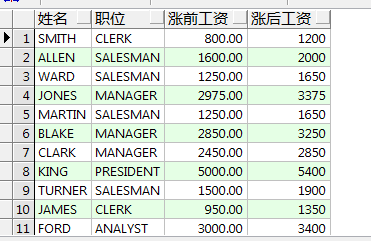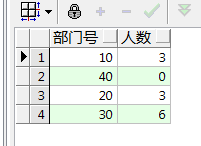【Oracle】Oracle练习
1.将职位是分析员的,工资+1000;职位是经理的,工资+800;职位是其它的,工资+400
使用case表达式
select ename "姓名",job "职位",sal "涨前工资",
case job
when 'analyst' then sal + 1000
when 'manager' then sal + 800
else
sal + 400
end "涨后工资"
from emp;使用decode函数实现
select ename "姓名",job "职位",sal "涨前工资",
decode(job,'analyst',sal +1000,
'manager',sal + 800,sal+400) "涨后工资"
from emp;
易错总结: 注意双引号和单引号的使用场景
单引号出现的地方如下:
1)字符串,例如:'hello'
2)日期型,例如:'17-12月-80'
3)to_char/to_date(日期,'YYYY-MM-DD HH24:MI:SS')
双引号出现的地方如下:
1)列别名,例如:select ename "姓 名" from emp
2)to_char/to_date(日期,'YYYY"年"MM"月"DD"日" HH24:MI:SS')‘’号中的英文字符大小写不敏感
2.统计不重复的部门
select count(distinct deptno) from emp;3.除10号部门外,查询部门平均工资大于2000元的部门
select deptno,avg(sal)
from emp where deptno <> 10
group by deptno;
select deptno,avg(sal)
from emp group by deptno
having deptno <> 10;
那么问题来了,having和where的区别是什么?
where和having的区别:
where:
1)行过滤器
2)针对原始的记录
3)跟在from后面
4)where可省
5)先执行
having:
1)组过滤器
2)针对分组后的记录
3)跟在group by后面
4)having可省
5)后执行
group by的使用场景又是什么?
1)在select子句中出现的非多行函数的所有列,【必须】出现在group by子句中
2)在group by子句中出现的所有列,【可出现可不现】在select子句中
3.使用外连接,按部门10,20,30,40号,统计各部门员工人数,要求显示部门号,部门名,人数
-- 左外连接
select d.deptno "部门号", count(e.empno) "人数"
from dept d,emp e
where d.deptno = e.deptno(+)
group by d.deptno,d.dname;
-- 右外连接
select d.deptno "部门号",count(e.empno) "人数"
from dept d,emp e
where d.deptno(+) = e.deptno
group by d.deptno,d.dname;
关于连接查询,可以参考http://blog.csdn.net/evan_qb/article/details/75208518
4.关于Oracle分页,显示emp表中5-9条记录
select yy.*
from (select rownum ids,emp.* from emp where rownum<=9) yy
where ids>=5;5.有【1000亿】条会员记录,如何用最高效的方式将薪水字段清零,其它字段内容不变?
第一:从emp表中删除sal字段
alter table emp drop column sal;
第二:向emp表中添加sal字段,且内容默认0
alter table emp add sal number(6) default 0;
6.笔试题3:有一个员工表empinfo结构如下
create table empinfo(
fempno varchar2(10) primary key,
fempname varchar2(20) not null,
fage number(2) not null,
fsalary number(10,2) not null
);
假如该表有大约1000万条记录,写一句最高效的SQL语句,计算以下4种人中每种员工的数量
第1种人:fsalary>9999 and fage>35
第2种人:fsalary>9999 and fage<35
第3种人:fsalary<9999 and fage>35
第4种人:fsalary<9999 and fage<35
提示:只用一条SQL搞定
select
sum(case when e.fsalary>9999 and e.fage>35 then 1 else 0 end) "第1种人",
sum(case when e.fsalary>9999 and e.fage<35 then 1 else 0 end) "第2种人",
sum(case when e.fsalary<9999 and e.fage>35 then 1 else 0 end) "第3种人",
sum(case when e.fsalary<9999 and e.fage<35 then 1 else 0 end) "第4种人"
from empinfo e;7.复制表格
-- 复制scott.emp表中的结构
create table emp as select * from scott.emp;